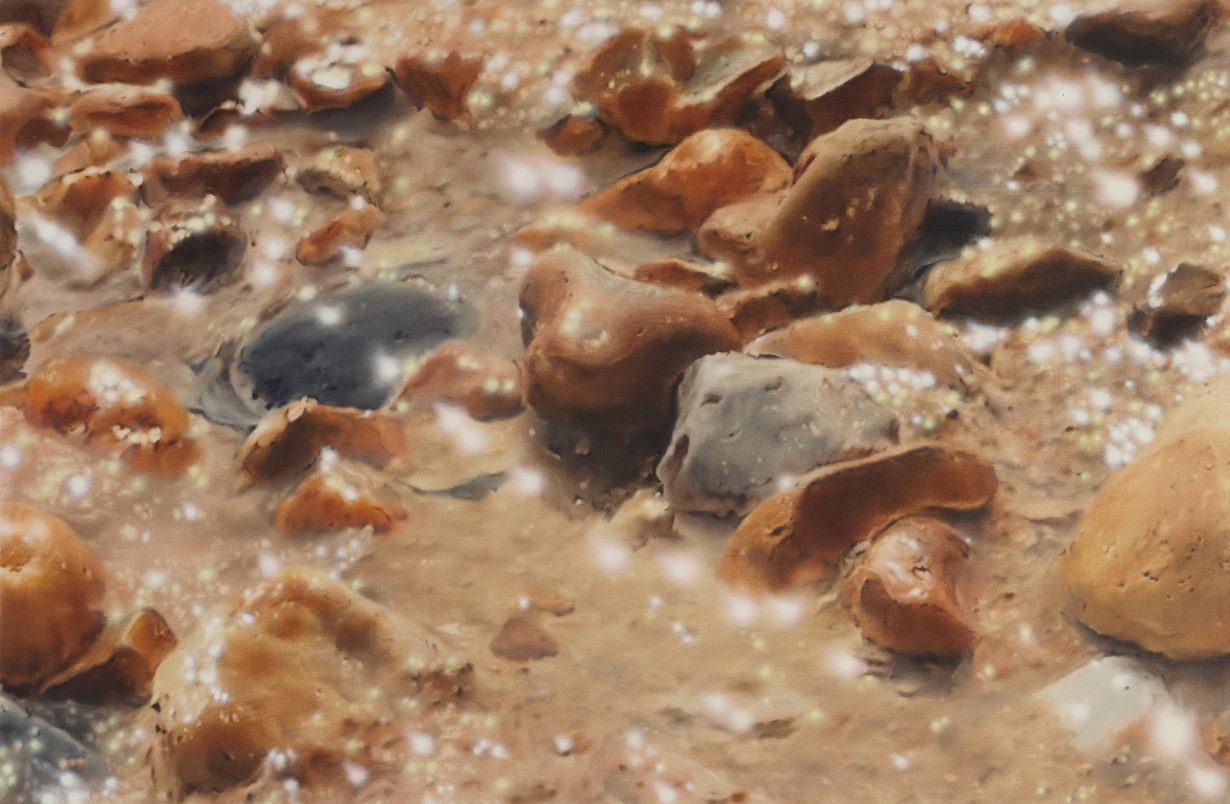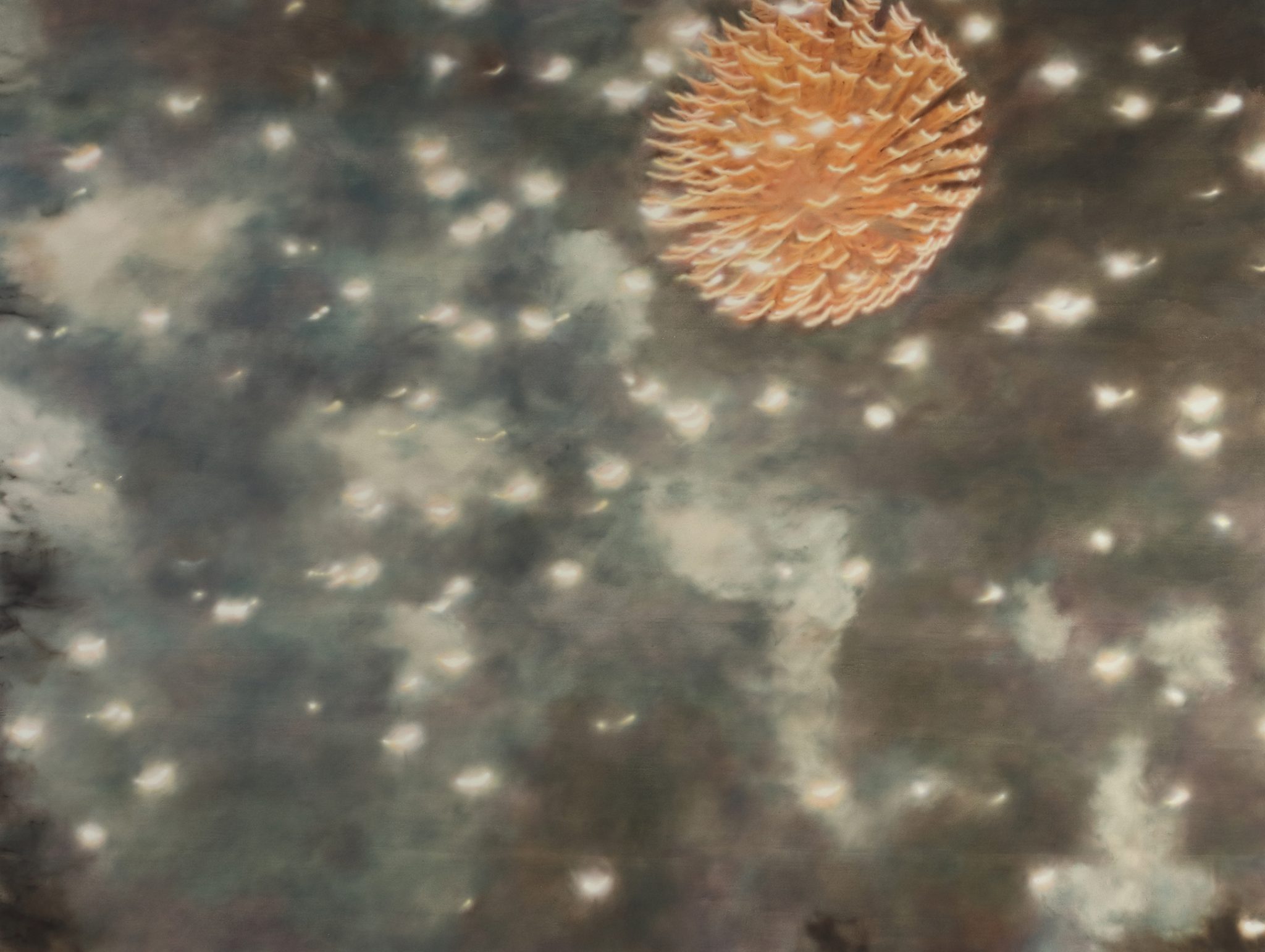Inspired by Cézanne and Ozu, the artist’s smallscale works are masterstrokes in economy and ellipsis
James Prapaithong’s paintings are concerned with how we see, not what we see. At least that’s the impression one gets from works such as Quietly Falling (all paintings 2024), a large blue-black rectangle that freezes a thousand twinkling tricks of the light: a complex ballet of shadows, reflections and wave patterns. It appears to explore what happens when low late afternoon sunlight, after bouncing off rippling water, enters the retina. Hanging next to it, The Night We Met is a fuzzier, soft-focus depiction of what seem to be clouds of smoke pinpricking a night sky, as a lone firework in the top-right releases a spherical ball of orange tracers. Prapaithong again seems more interested in the human visual system’s optical quirks than his indistinct subject matter. Is he trying to mimic the fallible vision of a roving eye midway through a saccadic movement, darting away from the action towards a new focal point? Or perhaps the events unfolding are so scattered, chaotic, fast and ephemeral that the mind struggles to process them into a coherent whole, or picture?
The seven paintings in Strange Trails, the London-based, Royal College of Arts-trained artist’s first solo show in his homeland, draw upon informal photographs and videos taken by him, or those close to him. Examples of these appear in Everyday Melancholy (2020–), a video stitching together long takes of the shimmering ocean, waves lapping, sleet falling beside a lamppost, a cobweb blowing in wind, sunlight penetrating a tree canopy and a passenger’s view from a moving car as it dashes past a touristy beach at dusk. If there’s a message these vignettes telegraph, it is that Prapaithong – who scrubs layers of paint into his canvases to create deep beds of colour, then applies thick white paint to denote specks of light – isprimarily concerned with capturing the constancy and intersubjectivity of memory and cognition, not the single moment or isolated event.

This is a tried-and-tested modus operandi, in painting and further afield. There is something of Paul Cézanne’s attempt to realise sensations, and the phenomenologists’ fascination with the texture of experience, at play here. Meanwhile, Prapaithong has singled out as an influence the film grammar of Yasujiro Ozu, namely the late Japanese director’s use of the ‘pillow shot’ – still-life shots of everything from empty interiors to passing trains and distant mountains – to divide, and punctuate, his dramatic scenes.
To invoke such greatness is, of course, to raise the stakes. But these reference points are not wide of the mark: Prapaithong’s paintings are masterstrokes in economy and ellipsis, wherein the carefully considered composition and play of light is always pregnant with meaning. Be it how a veil of trees creates a frame within our field of vision (Trail of the North Star), how daylight dazzles as it glints off the oscillating shallows of a rocky riverbed (Constellation in the Sand) or how the setting sun, when viewed from within an airplane window, causes awesome refractions at the edge of the earth (Horizon #3), his incidental moments each betray tinges, or trails, of a phenomenal consciousness that we know only too well. And, in so doing, they draw us in. Overwhelmingly, the sensation that attends our looking is one of bittersweetness – perhaps because looking reminds us that our perceptions are altogether private and unknowable by others, while also reaffirming that we are not alone in this regard.
Writing about the transcendental style of Ozu’s films back in 1972, the American filmmaker Paul Schrader drew heavily on the first koan of Zen philosophy, which concerns the concept of mu, or emptiness. Like Ozu’s celebrated pillow shots, or the gaps between stones in the artfully raked Japanese rock garden, Prapaithong’s placeless works can also be understood through this prism: emptiness is the active ingredient, and implies a human presence.
Strange Trails at Nova Contemporary, Bangkok, through 5 September
